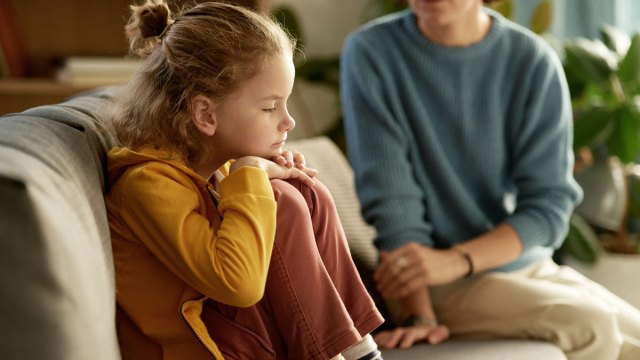Parents of big kids already know how challenging those years can be. As little ones grow up and start to learn to be independent humans, the way they express that they’re independent humans isn’t always ideal. Meltdowns, talking back, attitude—you’ve seen it all. And when they get upset, it can be like an impenetrable steel wall going up around them. Thankfully, mom and parenting coach Dr. Chelsey Hauge-Zavaleta has an amazing tip for chipping away at that wall when you have an angry big kid, and all it takes to start are a few “yes” statements.
Dr. Hauge-Zavaleta shared the “three yeses” technique in a TikTok video that promptly went viral because it’s pretty much genius.
@drchelsey_parenting My fave tool for big kids and teens. #drchelsey #positiveparenthood #positiveparenting #guidingcooperation #conscious parenting #gentleparenting #attunement #neurodiversechild #coregulation #parentingtips #parentcoach #moms #momsupport #family #consequences #adhdparenting #regulationtok #coregulationtok
♬ original sound – Dr. Chelsey HaugeZavaleta, PhD
“My favorite parenting tool for big kids or teens is called the three yeses,” she says in the video, then goes on to explain, “Let’s say your big kid or teen is mad, upset, frustrated, pissed off at you, all the things. Maybe you have an idea of what you should say or what the consequence should be, what they should do differently, or how to fix it. Maybe you even want to lecture them.”
She continues, “Hold up! We’re going to do the three yeses instead. This is not a tool that’s going to fix everything, but it is a tool that’s going to create connection and we’re going to use the connection to help your big kid or teen regulate and then resolve the issue on their own.”
The key, Dr. Hauge-Zavaleta explains, is to get out of your own perspective and see things from your child’s perspective. Then, give them three statements they can say yes to from their point of view.
She gives an example: A family goes on an annual vacation to a cabin with their grandparents and teen daughter, who has always been able to bring a friend, but because of a last-minute change of plans, she couldn’t this year. So while the rest of the family plays board games downstairs, she’s sequestered herself in a bedroom, refusing to play or hang out. Mom is over her attitude and wants to unplug the WiFi, but instead, she goes to the bedroom to try the three yeses. Dr. Hauge-Zavaleta shares three statements she might try:
- Wow, you really wanted to bring a friend.
- You do not want to go downstairs and play those babyish games.
- You’re counting the days ’til we go home.
And then, parents, you get to be quiet. “If your big kid doesn’t respond but you can feel in the air that there’s a shift, great,” she explains. “This builds the connection just a little bit.” If you’ve got it wrong, you should own up to the misunderstanding and try to get it right, which still opens the door. At that point, mom can ask, “Okay, what can we do here?” and put the ball in the daughter’s court. The daughter can then decide if she wants to rejoin the family for a game, take some time to chill, or whatever else, all in a calmer state knowing that her parent has connected with her and supports her.
Another example is a teen boy who fails his math test. While the parent’s first instinct is to jump to giving a consequence or upping their tutoring hours, Dr. Hauge-Zavaleta encouraged her to try the three yeses first, something like this:
- You were thinking that you could not study and the time you spent in class was enough.
- Yah, you thought you’d be able to pass that test because historically you’ve done OK in math.
- You’re kind of embarrassed about this whole thing and the grade.
While the son didn’t have a big reaction in the moment, later that night he came over to his mom and said, “I didn’t know you loved me.” What a breakthrough moment for this mom and her kid, who clearly felt the closeness she was trying to create. Yes, he still failed his math test and they’ll have to figure out how to prevent that from happening again, but now they can do it through a lens of love and communication.
Dr. Hauge-Zavaleta explains that the statements and connection create a foundation: The kids feel heard and understood, and the parent opens a door to communicate so they can reach an agreement and better understand each other.
No, it’s not a magic bullet that will solve all communication problems, but it’s a smart strategy worth trying—and all it takes is three simple sentences.











